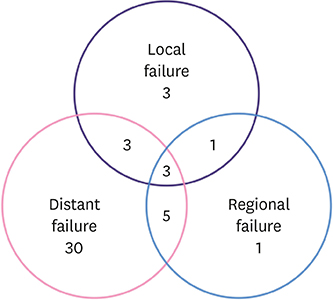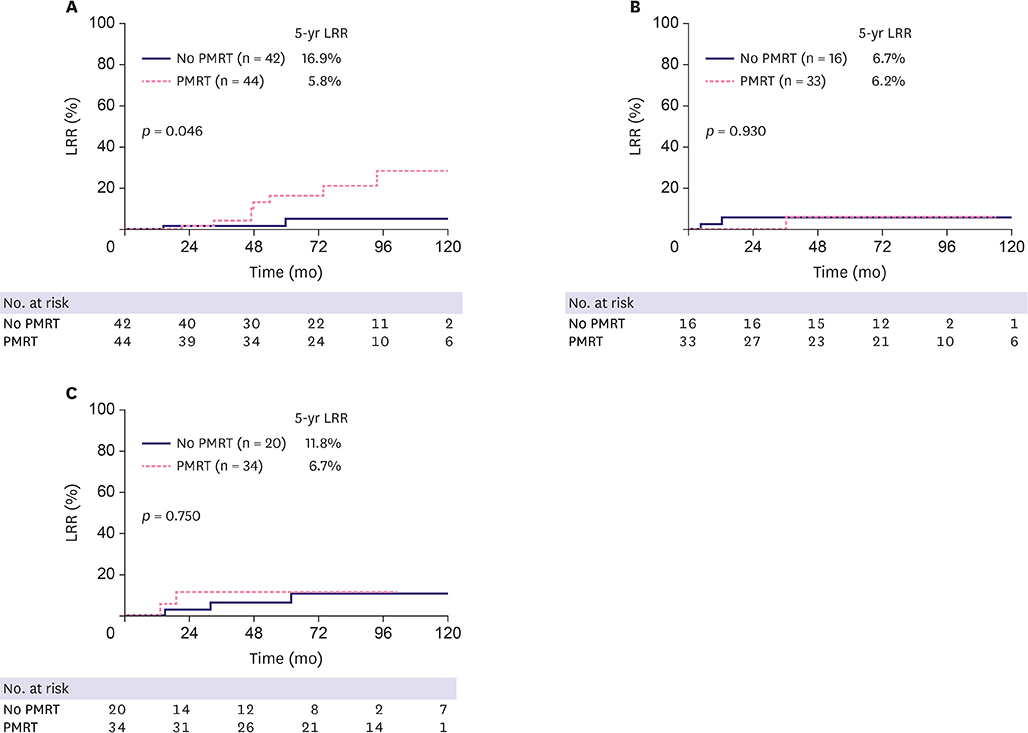J Breast Cancer.
2019 Jun;22(2):285-296. 10.4048/jbc.2019.22.e25.
The Benefit of Post-Mastectomy Radiotherapy in ypN0 Patients after Neoadjuvant Chemotherapy According to Molecular Subtypes
- Affiliations
-
- 1Department of Radiation Oncology, Samsung Medical Center, Sungkyunkwan University School of Medicine, Seoul, Korea. wonro.park@samsung.com
- 2Department of Radiation Oncology, Yonsei Cancer Center, Yonsei University College of Medicine, Seoul, Korea.
- 3Department of Radiation Oncology, Seoul National University College of Medicine, Seoul, Korea.
- 4Department of Radiation Oncology, Asan Medical Center, University of Ulsan College of Medicine, Seoul, Korea.
- 5Department of Radiation Oncology, Ewha Womans University School of Medicine, Seoul, Korea.
- 6Department of Radiation Oncology, Dongsan Medical Center, Keimyung University School of Medicine, Daegu, Korea.
- 7Department of Radiation Oncology, Chonnam National University Medical School, Gwangju, Korea.
- 8Department of Radiation Oncology, Chonbuk National University Medical School, Jeonju, Korea.
- 9Department of Radiation Oncology, Inha University Hospital, Incheon, Korea.
- 10Department of Radiation Oncology, Ajou University School of Medicine, Suwon, Korea.
- 11Department of Radiation Oncology, Konyang University College of Medicine, Daejeon, Korea.
- 12Department of Radiation Oncology, Chungnam National University College of Medicine, Daejeon, Korea.
- 13Department of Radiation Oncology, Inje University Busan Paik Hospital, Busan, Korea.
- KMID: 2450122
- DOI: http://doi.org/10.4048/jbc.2019.22.e25
Abstract
- PURPOSE
The benefit of post-mastectomy radiation therapy (PMRT) in patients with breast cancer who achieve ypN0 following neoadjuvant chemotherapy (NAC) has not yet been established. This study aimed to identify the role of PMRT in patients who achieve ypN0 according to molecular subtype.
METHODS
We identified patients initially suspected with axillary disease who achieved ypN0 following NAC. From 13 institutions of the Korean Radiation Oncology Group between 2005 and 2011, a total of 189 patients were included in the analysis. Effects of PMRT on loco-regional control (LRC), disease-free survival (DFS), and overall survival (OS) were evaluated for different molecular subtypes.
RESULTS
In all patients, the prognostic effect of PMRT on LRC, DFS, or OS was not significant. Subgroups analysis showed that the effect of PMRT on LRC was different according to molecular subtype (p for interaction = 0.019). PMRT was associated with greater LRC in the luminal subtype (p = 0.046), but not in other subtypes.
CONCLUSION
In patients who achieve ypN0 following NAC and mastectomy, PMRT shows no additional survival benefits for any molecular subtype.
MeSH Terms
Figure
Reference
-
1. Recht A, Comen EA, Fine RE, Fleming GF, Hardenbergh PH, Ho AY, et al. Postmastectomy radiotherapy: an American Society of Clinical Oncology, American Society for Radiation Oncology, and Society of Surgical Oncology focused guideline update. J Clin Oncol. 2016; 34:4431–4442.
Article2. Rastogi K, Sharma S, Gupta S, Agarwal N, Bhaskar S, Jain S. Dosimetric comparison of IMRT versus 3DCRT for post-mastectomy chest wall irradiation. Radiat Oncol J. 2018; 36:71–78.
Article3. EBCTCG (Early Breast Cancer Trialists' Collaborative Group). McGale P, Taylor C, Correa C, Cutter D, Duane F, et al. Effect of radiotherapy after mastectomy and axillary surgery on 10-year recurrence and 20-year breast cancer mortality: meta-analysis of individual patient data for 8135 women in 22 randomised trials. Lancet. 2014; 383:2127–2135.
Article4. National Comprehensive Cancer Network (US). NCCN clinical practice guidelines in oncology: breast cancer. Version 1. Plymouth Meeting: National Comprehensive Cancer Network;2018.5. Puig CA, Hoskin TL, Day CN, Habermann EB, Boughey JC. National trends in the use of neoadjuvant chemotherapy for hormone receptor-negative breast cancer: a National Cancer Data Base study. Ann Surg Oncol. 2017; 24:1242–1250.
Article6. Mamounas EP, Anderson SJ, Dignam JJ, Bear HD, Julian TB, Geyer CE Jr, et al. Predictors of locoregional recurrence after neoadjuvant chemotherapy: results from combined analysis of National Surgical Adjuvant Breast and Bowel Project B-18 and B-27. J Clin Oncol. 2012; 30:3960–3966.
Article7. Mak KS, Harris JR. Radiotherapy issues after neoadjuvant chemotherapy. J Natl Cancer Inst Monogr. 2015; 2015:87–89.
Article8. Shim SJ, Park W, Huh SJ, Choi DH, Shin KH, Lee NK, et al. The role of postmastectomy radiation therapy after neoadjuvant chemotherapy in clinical stage II–III breast cancer patients with pN0: a multicenter, retrospective study (KROG 12-05). Int J Radiat Oncol Biol Phys. 2014; 88:65–72.
Article9. Kyndi M, Sørensen FB, Knudsen H, Overgaard M, Nielsen HM, Overgaard J, et al. Estrogen receptor, progesterone receptor, HER-2, and response to postmastectomy radiotherapy in high-risk breast cancer: the Danish Breast Cancer Cooperative Group. J Clin Oncol. 2008; 26:1419–1426.
Article10. Tseng YD, Uno H, Hughes ME, Niland JC, Wong YN, Theriault R, et al. Biological subtype predicts risk of locoregional recurrence after mastectomy and impact of postmastectomy radiation in a large national database. Int J Radiat Oncol Biol Phys. 2015; 93:622–630.
Article11. Laurberg T, Tramm T, Nielsen T, Alsner J, Nord S, Myhre S, et al. Intrinsic subtypes and benefit from postmastectomy radiotherapy in node-positive premenopausal breast cancer patients who received adjuvant chemotherapy - results from two independent randomized trials. Acta Oncol. 2018; 57:38–43.
Article12. Kantor O, Pesce C, Singh P, Miller M, Tseng J, Wang CH, et al. Post-mastectomy radiation therapy and overall survival after neoadjuvant chemotherapy. J Surg Oncol. 2017; 115:668–676.
Article13. Liu J, Mao K, Jiang S, Jiang W, Chen K, Kim BY, et al. The role of postmastectomy radiotherapy in clinically node-positive, stage II–III breast cancer patients with pathological negative nodes after neoadjuvant chemotherapy: an analysis from the NCDB. Oncotarget. 2016; 7:24848–24859.
Article14. Le Scodan R, Selz J, Stevens D, Bollet MA, de la Lande B, Daveau C, et al. Radiotherapy for stage II and stage III breast cancer patients with negative lymph nodes after preoperative chemotherapy and mastectomy. Int J Radiat Oncol Biol Phys. 2012; 82:e1–e7.
Article15. Rusthoven CG, Rabinovitch RA, Jones BL, Koshy M, Amini A, Yeh N, et al. The impact of postmastectomy and regional nodal radiation after neoadjuvant chemotherapy for clinically lymph node-positive breast cancer: a National Cancer Database (NCDB) analysis. Ann Oncol. 2016; 27:818–827.
Article16. Rong QL, Wang SL, Tang Y, Jin J, Song YW, Wang WH, et al. The role of postmastectomy radiotherapy in clinical T1-3N1M0 breast cancer patients with pathological negative lymph nodes after neoadjuvant chemotherapy and mastectomy. Zhonghua Zhong Liu Za Zhi. 2017; 39:445–452.17. Hamy AS, Lam GT, Laas E, Darrigues L, Balezeau T, Guerin J, et al. Lymphovascular invasion after neoadjuvant chemotherapy is strongly associated with poor prognosis in breast carcinoma. Breast Cancer Res Treat. 2018; 169:295–304.
Article18. Liu YL, Saraf A, Lee SM, Zhong X, Hibshoosh H, Kalinsky K, et al. Lymphovascular invasion is an independent predictor of survival in breast cancer after neoadjuvant chemotherapy. Breast Cancer Res Treat. 2016; 157:555–564.
Article19. Ryu YJ, Kang SJ, Cho JS, Yoon JH, Park MH. Lymphovascular invasion can be better than pathologic complete response to predict prognosis in breast cancer treated with neoadjuvant chemotherapy. Medicine (Baltimore). 2018; 97:e11647.
Article20. Nagar H, Mittendorf EA, Strom EA, Perkins GH, Oh JL, Tereffe W, et al. Local-regional recurrence with and without radiation therapy after neoadjuvant chemotherapy and mastectomy for clinically staged T3N0 breast cancer. Int J Radiat Oncol Biol Phys. 2011; 81:782–787.
Article21. Truong PT, Sadek BT, Lesperance MF, Alexander CS, Shenouda M, Raad RA, et al. Is biological subtype prognostic of locoregional recurrence risk in women with pT1-2N0 breast cancer treated with mastectomy? Int J Radiat Oncol Biol Phys. 2014; 88:57–64.
Article22. Jagsi R, Raad RA, Goldberg S, Sullivan T, Michaelson J, Powell SN, et al. Locoregional recurrence rates and prognostic factors for failure in node-negative patients treated with mastectomy: implications for postmastectomy radiation. Int J Radiat Oncol Biol Phys. 2005; 62:1035–1039.
Article23. Abi-Raad R, Boutrus R, Wang R, Niemierko A, Macdonald S, Smith B, et al. Patterns and risk factors of locoregional recurrence in T1-T2 node negative breast cancer patients treated with mastectomy: implications for postmastectomy radiotherapy. Int J Radiat Oncol Biol Phys. 2011; 81:e151–e157.
Article
- Full Text Links
- Actions
-
Cited
- CITED
-
- Close
- Share
- Similar articles
-
- Comparison of the Clinical Outcomes Between Neoadjuvant Chemotherapy and Radiotherapy Alone in Patient with Cervical Cancer
- Evaluation of Pathologic Complete Response in Breast Cancer Patients Treated with Neoadjuvant Chemotherapy: Experience in a Single Institution over a 10-Year Period
- Impact of Postmastectomy Radiation Therapy on Breast Cancer Patients According to Pathologic Nodal Status after Modern Neoadjuvant Chemotherapy
- Using the Lymph Node Ratio to Evaluate the Prognosis of Stage II/III Breast Cancer Patients Who Received Neoadjuvant Chemotherapy and Mastectomy
- Prognostic Factors in Patients with Locally Advanced Breast Cancer Treated by Neoadjuvant Chemotherapy



